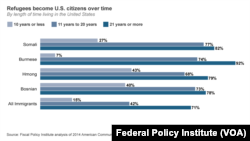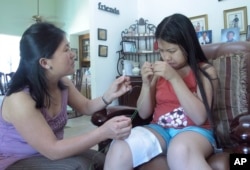To escape areas of conflict, refugees leave everything behind.
They are resilient, advocates say, but an “important” part of their journey comes when adapting to their new home.
During a panel discussion last week in Washington about refugee resettlement, advocates reviewed the importance of local government being part of helping newcomers become familiar with a new reality.
“While refugee resettlement is a matter of global importance, there’s need to find durable permanent solutions. This is not the time to pull back, but rather an opportunity to lead by example,” said Winnie Stachelberg, executive vice president of external affairs at the Center for American Progress.
Cities like Fargo, in North Dakota, are not “pulling back.” According to Mayor Tim Mahoney, the community has come together to help refugees recover and build new lives.
“We have a great growing city. Good economy and things are happening,” Mahoney said, adding that every year about 500 refugees move to Fargo.
“We have found them an important part of our work force … Our new Americans are an important part of our structure and work with us very much all the time."
'Healthily' competing
Mahoney said the city has a network of 33 businesses “healthily” competing to have newcomers work for them.
Fargo is working on a bus pass program to help people get to work. A police liaison was chosen to assist refugees to feel comfortable with law enforcement, and a community center offers English classes to help the new residents overcome language barriers.
Mahoney said refugees have brought a lot of things to the community such as culture, food and religion. The city of approximately 250,000 has been growing for 15 years and in the next five years, he said it will have 30,000 new jobs available.
Sussan Khozouri, senior vice president at long-time refugee resettlement agency HIAS, said employment continues to be one of the newcomers’ most important priorities.
Khozouri said by the time refugees arrive in the country, the U.S. government has already identified “that these people are of humanitarian concern to the U.S., and they will have the right to work and residence status within a year of arriving, and citizenship status within five years if they choose it.”
HIAS helps with things such as culture orientation and school information to children. “We are there as the port of entry sort of speak,” she said.
World Refugee Day
Ahead of Monday’s celebration of World Refugee Day, the Center for American Progress released a new report and found that once refugees are rooted in the U.S. they see a “substantial” wage gain, help expand the local economy, and learn to speak English “well” or “very well.”
For the past five years the study looked at census data and identified four groups consisting primarily of refugees — Somali, Burmese, Hmong, and Bosnians— and found they quickly became self-sufficient.
Thirty-one out of 1,000 Bosnian refugees are business owners, while 26 of every 1,000 Burmese in the labor force are business owners.
After living in the U.S. for more than 10 years, 86 percent of Somalis speak English “well” and 61 percent speak “very well.” Among Hmong refugees, 43 percent speak only English or speak it“very well.”
David Kallick, senior fellow at the Fiscal Policy Institute, said the study also looked at refugee women in the workforce.
“You see in three of the four groups we looked at when they [women] first came [to the U.S.] women’s labor force participation rates were relatively low compared to the U.S.-born women. But by the time they’ve been here for 10 years they were all at the same level or higher than U.S.-born women,” Kallick said.
Advocates said there is still a “great need” to help refugees and urged the United States and other nations to do more.
“The release of the report is timely,” Stachelberg said, “not just because people across the world will celebrate World Refugee Day but more importantly because the world is currently facing one of the largest refugee crises in our lifetimes.”
Forcibly displaced
According to the United Nations High Commissioner for Refugees, there are now nearly 60 million forcibly displaced people worldwide. Some of the highest numbers come from Syria, Afghanistan, Somalia and the Democratic Republic of the Congo.
The Obama administration plans to admit 10,000 Syrian refugees in FY 2016 as part of an overall goal to admit 85,000 refugee from around the world.
Michel Gabaudan, president of Refugees International, an advocacy organization that works with refuges from all over the world, said in a phone interview that some countries believe the refugee crisis is temporary.
But Gabaudan urged them to understand that the crisis is not temporary and called upon government agencies to aid refugees in recovering to a normal life.
He added there are still very few examples of governments that act at the local level, but agreed that local integration is key to help a refugee family rebuild.
“This is where I think we have to put much more attention as of now, and some discussion has already started,” he said.











